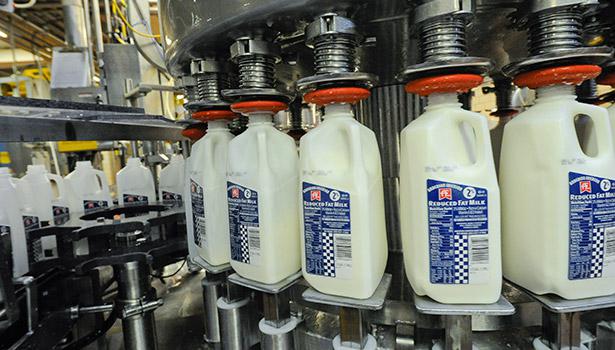5 Advantages of Electrocoagulation for Dairy Wastewater Treatment

From an anthropological standpoint, humans don’t really need to consume milk-based products. This is evidenced by the existence of lactose intolerant people. Even so, people enjoy dairy products. There’s nothing quite like a bowl of ice cream on a hot day or a cold glass of milk with an oven-fresh cookie. I myself am a big fan of cheese in many forms: grilled cheese, macaroni and cheese or string cheese. Therefore, with all of these dairy products being consumed, dairy wastewater treatment is important to support this industry.
Since, the global consumption and demand of dairy products is large, the dairy industry is pretty large. Like with many other foods and beverages, water is a considerable component in their production. Since milk is one of the main ingredients of dairy products, water is not used much as an ingredient, but it is highly used for cleaning and washing, disinfection, and heating & cooling. Therefore, dairy wastewater treatment solutions are required to handle these requirements.
Depending on the product and production methods, wastewater from dairy facilities can contain a number of different contaminants. These contaminants typically include TSS, BOD, COD, nitrogen, phosphorus, fats, oils, and grease. In this article, we’re going to look at the use of optimized electrocoagulation (EC) as an integrated solution for dairy wastewater treatment plants.
Listed below are five important benefits of the use of EC for dairy wastewater treatment.
Sedimentation and Flocculation
One of the main reasons coagulation treatments are used so often is due to their propensity for both sedimentation and flocculation of particles in dairy wastewater treatment. These particulates can include heavier particulates that would be settled at the bottom of the reaction tank and lighter substances like fats that can be floated to the top. In an electrocoagulation process, the charge supplied to the electrodes — and the resulting metallic ions released from the anode — cause the solution to destabilize and cause solids to coagulate and precipitate out of solution while bubbles produced on the cathode lift lighter particles to the top of the tank as floc. This process allows for easier solids separation in a post clarification process.
The New Value of Sludge
Sludge is a very common product of coagulation processes. With chemical coagulation, the sludge is quite abundant and harmful due to chemicals used in this process. With EC, there are no chemical additives (not counting pH adjustment) so the produced volume of sludge is lower and the sludge is often non-hazardous. As an added bonus, this non-hazardous sludge generated by the dairy wastewater treatment process can actually be put to use elsewhere.
Nitrogen and phosphorus are commonly used in fertilizers as they aid in healthy plant growth. The nitrogen and phosphorus in dairy wastewater will precipitate into the sludge during the EC process and that sludge could potentially be sold to local farms or horticular companies as a beneficial soil additive.
Potential to Recycle Fats
Unless it’s whole milk, other types of milk have reduced fat contents. 2%, 1%, and skim milk have all had some portion of the original raw milk fat content removed. That leftover fat can end up in the wastewater from the production facility. As mentioned previously, fats are floated to the top of the tank during the EC process by the bubbles produced from the cathode.
This fat, along with other flocculated particles from dairy wastewater treatement, can be skimmed off the top of the solution. The fat can then be separated from the rest and potentially used as a recycled energy source for the plant. One potential application could be as a heat source for any boiling units in the process.
Ease of Operation and Maintenance
Once the details of the system have been ironed out, like the optimal pH, optimal current density, and optimal electrode material and arrangement, the EC system is relatively easy to operate. Larger systems are automated to simplify operation even further. The design of EC systems also keeps maintenance easy and minimal.
Water Reuse
It is important now and into the future, that companies become more conscious of their raw water usage in the face of water scarcity. As a large user of raw water, the dairy industry must find ways to be more sustainable in their water usage. One way to do this would be by reusing wastewater.
With an effective treatment system for dairy wastewater treatment, this can be done easily. Specialized Electrocoagulation is one such treatment method, which is integrated with other processes, including filtration, clarification and a disinfection unit to polish/remove any remaining biological contaminants. Sufficiently treated wastewater can be reused for processes like equipment cleaning or cooling. In addition, by reusing wastewater, operating costs associated with raw water consumption can be reduced for the dairy company.
Electrocoagulation is an advanced treatment process that is meant to optimize the efficiency and cost of wastewater treatment. In the dairy industry, it has several benefits as outlined above.
Genesis Water Technologies is a leader in electrochemical technology and its integration into a dairy wastewater treatment system. We have utilized our own advanced EC systems with past clients in this industry, and helped them improve their wastewater treatment process to meet regulatory guidelines and meet sustainability goals. This has improved their brand image to their clients.
If you are interested in the benefits that an electrocoagulation system could provide for your dairy wastewater treatment process, do not hesitate to call Genesis Water Technologies, Inc. at 1-877-267-3699 or email us at customersupport@genesiswatertech.com to setup a free initial consultation to discuss your specific application.

